Thought Series: Busting Value Stock Myths
An investigation of what creates skepticism around value stocks, and six of the many myths that reappear time and again.
Corporate Engagement Update Q4 2021
Through our corporate engagement partner As You Sow, Bailard recently signed on to an Investor Statement calling for Workplace Equity Disclosure. In 2019, the original Investor Statement was sent to 3,000 companies. According to As You Sow, “within the S&P 100 alone, between this August and last, EEO-1 disclosure increased by 239% (23 to 78) and we have seen a 289% (9 to 35) increase in companies setting explicit diversity goals”. However, reporting on recruitment, retention, and promotion rates by race and ethnicity remains inexcusably low. Therefore, Bailard has reaffirmed our commitment to this statement, which will be sent to all members of the Russell 1000, along with a tailored request for additional reporting of diversity, equity, and inclusion data.
Country Indices Flash Report – November 2021
Monthly MSCI EAFE and ACWI ex-U.S. returns were the worst since March 2020 as a taper tantrum hit equities hard. Chairman Powell’s comments at month-end increased concerns that ongoing inflation could lead to faster tapering and a shorter horizon until the Fed may consider raising short-term rates.
COP26 Issue Brief
We cover the importance of COP26 UN Climate Change Conference, some key highlights out of the conference on climate change, and targets and actions needed for the future.
Country Indices Flash Report – October 2021
Muted expectations for global economic growth in the 3rd quarter haven’t dented the season’s earnings reports so far. Equity markets – nearly across the board – have responded with strong results in October following September’s downturn.
Chat with the CIO: Shifting Tides in the ESG Landscape
 This quarter dives into the investment community’s increased focus on climate with Bailard’s Director of Sustainable, Responsible and Impact Investing Blaine Townsend, CIMA® and Chief Investment Officer, Eric P. Leve, CFA.
This quarter dives into the investment community’s increased focus on climate with Bailard’s Director of Sustainable, Responsible and Impact Investing Blaine Townsend, CIMA® and Chief Investment Officer, Eric P. Leve, CFA.
September 30, 2021
Eric P. Leve, CFA: You’ve been in the ESG business since the 1990s Blaine, what’s your perspective on the increased interest from investors?
Blaine Townsend, CIMA®: ESG investing has been around as a truly professional investment offering for 50 years, but in the past 18 months we’ve seen a total capitulation in the market. I think it was a collision of long-held and hard-fought wins by the ESG (environmental, social, and governance) and socially-responsible investing (SRI) community validated by external factors too hard to ignore; I’ll name climate risk, gender and ethnic inequality, and poor corporate governance for just a few. There has come a maturation of thinking, and a recognition that balancing social well-being and economic growth should not be seen as mutually exclusive.
Eric: Let’s spend some time with the first factor you just mentioned. Where does climate rank amongst the ESG factors investors should consider?
Blaine: It is at the top of the list. It has the potential to totally transform markets over the next 10 or 20 years and long-term investors must understand the level of climate risk in their portfolios.
If you’ll give me a moment to elaborate, forward-looking ESG analysis works to assess the materiality of nontraditional data and determine which companies are best prepared to compete in the world ahead. This framework is built on identifying long-term risk factors and then identifying investment opportunities based on these risks.
With respect to climate, scrutiny around the potential long-term risks here has been building like steam in a kettle for some time. Climate scientists were concerned by what their models were showing as early as the 1980s, yet public debate has raged in the decades since.
Eric: So tell me then, why climate now? Is this just a question of stranded assets and exposure to oil and gas majors? Or are there other implications?
Blaine: The growing focus on limiting climate change is expected to decrease demand for coal, oil, and gas, as well as the infrastructure required to get them out of the ground. This can then turn these commodities into “stranded assets” that will never be fully utilized. The stranded assets argument is a good starting point, because all that’s required for that thesis to play out is for regulators around the world to make it harder and more expensive to take carbon out of the ground. That is already happening. The stage is set for further transformation.
2021 has certainly seen growing support for “Net Zero” commitments being made by countries, municipalities, and companies around the world to counterbalance the emissions released with those removed by 2050. To paraphrase the words of the United Nations, for a livable world, these Net Zero commitments must be backed by true action. If market participants genuinely commit to Net Zero and work to limit the rise in global emissions to 1.5 degrees Celsius by 2050, the markets can’t help but be reshaped in 20 years. Energy transition and decarbonization will become massive drivers of capital investment and will reshape the market. For example, there will be entire new segments of the market focusing on transitional energy and carbon sequestration. Net Zero cannot happen any other way.
Eric: Clearly, this could be transformational. So Blaine, tell me what you see next on the horizon.
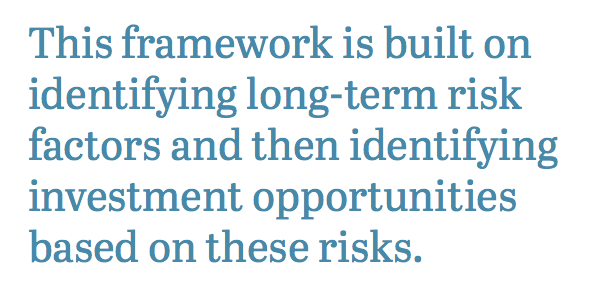
Blaine: There are solutions that are market ready but not deployed. For example, don’t be surprised if we soon see vertical farming or mandates on buildings to sequester carbon. There will be entire value chains created to support these industries. There will be new tools designed to measure and improve efficiency in business, in the home, and within transportation. Consider that the electric vehicle revolution hasn’t even really started yet. We really don’t even have widespread charging stations and, there’s many yet-to-be built businesses and processes there. Consumer products and consumer behavior will be reshaped by this transition. The industry sectors and market leaders 20 years from now may look nothing like they do today… much like the leadership of the Dow Jones Index has changed so dramatically over the past half a century.
Eric: How is the investing community impacted by the regulatory backdrop on climate?
Blaine: For many of the most important climate related disclosures, the framework is still evolving. The Securities and Exchange Commission (SEC) recognized climate change in 2010 as a material risk that should be disclosed, but the regulators are just now moving toward substantial change. It is a tricky situation because we remain stuck in an era of voluntary reporting on many crucial climate-related issues that are financially material to investors – and the clock is running.
For example, take what are called Scope 3 emissions. These are the emissions related to the entire value chain of a product or service and make up the lion’s share of a company’s emissions. From some oil majors, for example, Scope 3 emissions account for 90% of their total emissions. Very few companies have pledged to disclose their Scope 3 emissions, much less reduce them. And, as I said, if they do disclose them, it is purely voluntary. The good news is that, by and large, the market players want the regulatory regimes to make disclosure mandatory. There is evidence of this in every major jurisdiction around the world. Investors want to know which companies are reporting their emissions, and which aren’t.
The SEC’s comments I mentioned reflect a long and sustained movement by responsible investors who maintain that environmental, social, and governance issues are material to the long-term performance of a stock. By contrast, Wall Street has only recently turned its considerable intellect to this type of analysis, but the shift is gaining momentum. I firmly believe climate will be the single-biggest influence on investment performance out of any other factor over the next 25 to 30 years. It has moved from a political and cultural debate to a reality that companies, governments, and individuals alike are facing.
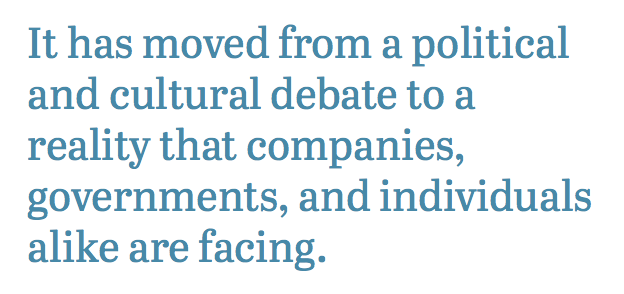
The fact that non-traditional risk factors like climate change have become widely accepted as real risks to financial and business returns makes sense. It is based on empirical observation, not emotional reaction.
Eric: This makes for a strong argument that the tides have turned. We are seeing the confluence of a growing body of data from companies, increasing investor interest, and a global recognition of the need to address our long-term risks. Thanks, as always, Blaine for leading the charge.
Country Indices Flash Report – September 2021
Rising inflation, slowing economic growth forecasts and inklings of a 2013-like taper tantrum weighed on global equities in September. Japan, often a winner in risk-off environments, and energy exporters bucked the trend.
Busting Value Stock Myths
Thomas J. Mudge III, CFA, Director, Equity Research Investment, introduces his research related to busting six value stock investing myths. Here we dive into what creates skepticism around value stocks, and the one myth that can’t be solved.
September 30, 2021
MythBusters was a long running television show on the Discovery Channel where the plausibility of commonly held wisdom or beliefs were scrutinized to determine their validity using scientific tests and experiments. Some of the myths tested on the program were confirmed as true. Apparently you can dip your wet hand into molten lead briefly and remove it unscathed (due to the Leidenfrost effect). Other myths were viewed as plausible. If you drive a convertible car with the top down fast enough in a rainstorm, (+90 mph) you may not get wet (just imperil the safety of yourself and others). Of course, many of the myths tested turned out to be false and were busted. A goldfish’s memory actually lasts for months at a minimum, not three seconds as is widely believed. The world of finance has its share of myths as well, and many center around value stocks and value stock investing.
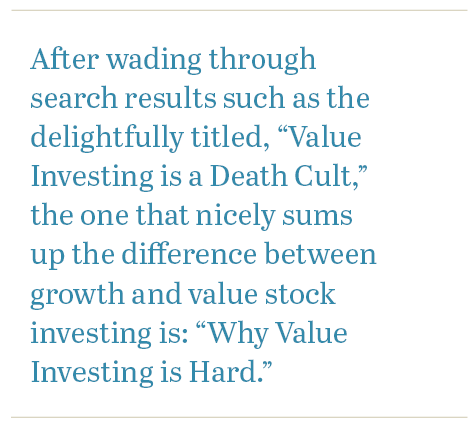
As long-time value investors, we see a healthy amount of skepticism. If you Google “death of value investing,” you get over 60 million hits; if you then try “death of growth investing,” there’s only about half as many (35 million).
Growth Stocks are Easy to Like
Growth stocks are like symmetrical faces or the golden ratio in art, people seem instinctively predisposed to like them. The narratives attached to growth stocks primarily emphasize the positive, with words and phrases like game changer, revolutionary, cutting edge, scalable, disruptive, next generation, and category killer. Growth companies are on average more profitable, less cyclical, and of course faster growing than value companies, and their path toward further prosperity appears clear.
In contrast, value stocks typically have one or more visible and sometimes scary problems in addition to their generally slower growth and lower profitability. Value companies often reside in less exciting and old-fashioned industries like commercial printing, food processing, healthcare facilities, and footwear. Their road to future success is often unclear or difficult to imagine. It is frequently difficult to get excited about value stocks. Perversely, it is precisely this lack of investor excitement that has made value investing lucrative historically.
Two Camps of Skeptics
The source of most value stock myths come from two different but closely related camps. The “never value” group is philosophically and/or temperamentally opposed to value investing. Another set of myths comes from the “maybe value, but not right now” camp. This group sees merit in value investing, but can usually find a reason why the timing just isn’t right.
In the minds of both groups, growth stock outperformance is the natural order of things, occasionally interrupted by abnormal or extraordinary events, but destined to resume its inevitable triumph over value in short order.
To be fair, for much of the past decade—but particularly the period of 2017 through the first three quarters of 2020—growth stocks have been the place to be. Growth stocks handily outperformed value stocks during this stretch, and the initial stages of the pandemic exacerbated the relative performance gap. As students of behavioral finance, we realize the power recent experience has on investor preferences, and it is understandable growth would be particularly popular after all that success.
The prevailing order shifted dramatically when value began massively outperforming from October of 2020 through March of 2021. But, since then, value has given back much of those relative gains and still has a long way to go to even the score.

Can value stocks return to past levels of relative success?
We believe that value stocks can, and will, catch up. In our forthcoming, full-length research piece titled, “Busting Value Stock Myths”, we examine six of the many myths regarding value stocks that resurface time and again (see Exhibit 1).
As a prelude, let’s take a moment to evaluate the one myth that is neither busted nor confirmed in Bailard’s research, as it reveals much about investors’ behavior.

This time, it’s different.
It is impossible to prove or disprove the myth that the world has changed, and that conditions are different this time. The world is always changing, though the pace of change certainly varies over time. Innovation and disruption may produce a coming golden age for growth companies, or competition, regulation, intellectual property theft, another Carrington Event (geomagnetic storm), or even plain old reversion to the mean could produce just the opposite. No one knows, but given the current relative valuation starting point between growth stocks and value stocks, “this time is different” appears to be already priced in as suggested in Exhibit 2.
“People are disturbed not by events, but by the view they take of them.”
This quote from philosopher Epictetus memorializes that the power of expectations has been recognized since at least the time of the ancient Greeks. It is as true today as it was almost 2,000 years ago that people’s (and investors’) expectations determine how, and how strongly, they react to events. Most events in life have expectations built in, and expectations have the biggest impact when actual events deviate from them, particularly in the opposite direction.
Human nature tends to lead investors toward excessive optimism, overconfidence in their predictive abilities, and an inclination toward anchoring their predictions based upon recent past trends. Given these biases, and an uncertain future, what types of stocks are likely to be cursed with high expectations, and which are blessed by having to deliver very little in order to pleasantly surprise? Perhaps history offers some clues?

As you can see in Exhibit 3, stocks where high expectations are built in—growth stocks both large and small—have underperformed value stocks over the long run.
Kale, Quinoa, and Turnips
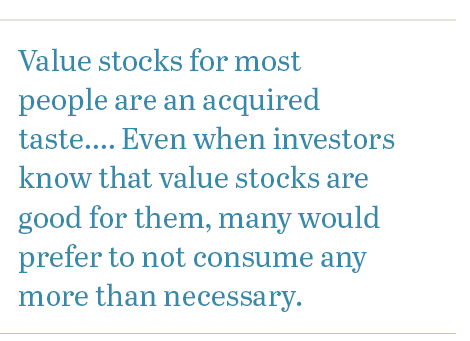
Value stocks for most people are an acquired taste. Value investing requires going against the conventional wisdom, and being wrong about 40% of the time. No matter how many myths about value investing are “busted,” the value premium has not been arbitraged away even though it is widely recognized for the same reason that health foods do not dominate the shelves of most grocery stores. Even when investors know that value stocks are good for them, many would prefer to not consume any more than necessary. Value investors have historically been compensated with higher returns for exposing their portfolios to the greater discomfort and uncertainty associated with value stocks, but that is a price that not everyone is willing to pay.
We can also argue that growth and value are both somewhat artificial constructs. By definition, even a growth manager is seeking undervalued companies within their universe. No matter what space you’re investing in, having a perception that differs from the broad market is the only way to win. Most importantly, this debate emphasizes the critical role that active management plays for growth and value investing alike. Testing the validity of theories and rumors to bust the myth and expose the truth is not only entertaining and insightful, but can aid in the effort to actively manage portfolios, their risk, and ultimately their performance.
Country Indices Flash Report – August 2021
Developed markets’ success enjoyed for the month was led by Western European markets. Within the region, financials and technology led the charge.

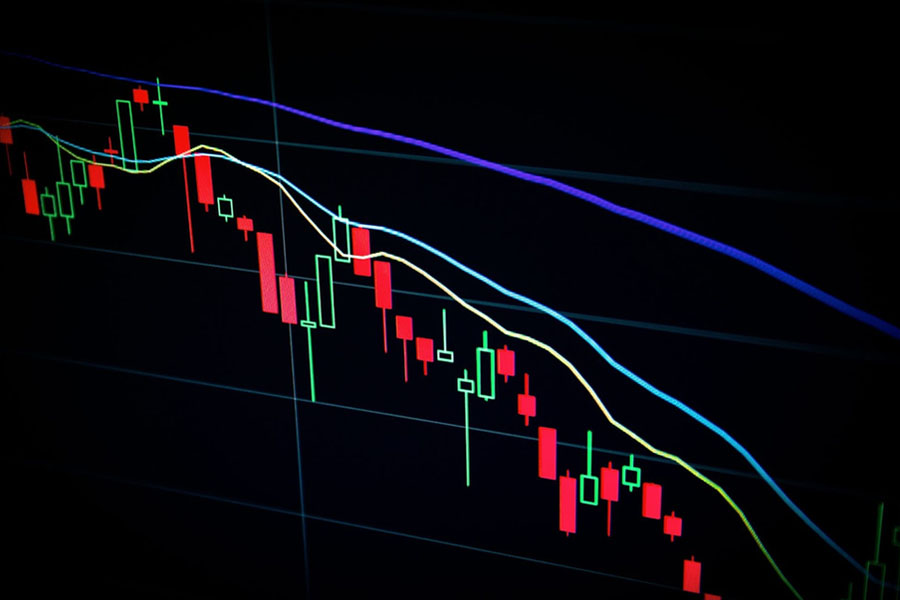
Themes for ESG Investing in 2022
Blaine Townsend, CIMA®, Director of Bailard’s Sustainable, Responsible, and Impact Investing Group, highlights decarbonization as a crucial ESG investing focus for the coming year.
December 31, 2021
Climate was the central ESG theme in 2021, and it’s near impossible that it won’t be again in 2022. In fact, it will remain so in the decades ahead. To riff off of Frank Sinatra: It is a Net Zero world and we are just living (and investing) in it.
The term “Net Zero”—awash in the headlines and political platforms worldwide—describes the balance between the amount of greenhouse gas emissions versus the amount removed from the atmosphere. The goal is to reach Net Zero in these emissions by 2050 to avoid the most catastrophic effects of climate change. Greenhouse gas concentrations are at their highest levels in two million years and, currently, the earth is roughly 1.1° Celsius warmer than it was in the 1800s and on track to increase by as much as 4.4 degrees by the end of the century.(1) Committing to Net Zero emissions is the path to curbing global temperature rise.
The commitment of nearly 200 countries Using this relative comparison to the pre-industrial period, scientists and governments agreed that holding the global temperature rise to 1.5 degrees Celsius would limit the worst climate impacts (as part of the 2015 UN Climate Change Conference, COP21, in Paris). (2)
Known as COP26, the five-year follow-up to the Paris Agreement was held this past fall in Glasgow. Progress was made in Scotland, particularly around the framework for pricing carbon, but the global community is moving too slowly and is not on track for Net Zero by 2050. The key to Net Zero is cutting emissions as soon as possible to reduce the absolute amount of the carbon budget being spent along the way. The Intergovernmental Panel on Climate Change [IPCC] re- ports that emissions must be halved by 2030 in order to even have the possibility of limiting warming to 1.5 degrees by 2050. (3)
Getting on the 1.5-degree path as quickly as possible matters. And this is where the potential for ESG in- vesting comes in. The race to “Net Zero” will have a transformative effect on the investment landscape and capital markets, as well as the way in which companies themselves operate.
Investment opportunities based on Net Zero While helpful as a strategic commitment, pledges from political jurisdictions are only words, and the work of reducing net emissions is done on the ground. With carbon as the primary greenhouse gas, it garners much of the focus. Decarbonization—which is the road to carbon-neutrality—will be led by rethinking the sectors that generate the bulk of the emissions, including electricity generation, transportation, buildings, and agriculture among others.
Decarbonization is expected to be a vital area for new capital investment and an important ESG theme ahead. Already, the investment opportunities for sequestering carbon (pulling already-emitted carbon out of the atmosphere), offsetting carbon elsewhere (through land restoration or planting of trees), and new technologies (to reduce emissions in the first place) are growing rapidly. It will just take a massive amount of investment of capital before it really takes off.
Pledges at the company level In addition to commitments from countries and municipalities around the world, numerous companies have made Net Zero pledges. Right now, big business is internalizing and communicating its path to Net Zero to investors based on largely voluntary disclosures and voluntary reporting. ESG investors would definitely like to understand where companies are with respect to these pledges. Once regulators agree on which disclosures should be required and standardized, companies will be better able to produce interim targets for the markets. Interim targets are extremely important because they force the decisions makers to stay accountable, particularly as CEOs typically operate with five- to seven-year time frames.
Additionally, the slow progress is vexing for ESG investors still in search of the best data possible to track portfolio alignment with Net Zero goals. ESG investors are eager for true science-based targets [SBTs] to better understand the risks in investment portfolios.
The financing gap There is a well-discussed gap between necessary infrastructure capital investment and new innovation required to decarbonize the global economy. This gap needs to close. The financial services industry has been slowly investing in decarbonization (by way of instruments like “green bonds”), but the pace needs to quicken and the commitment needs to grow or alternative funding schemes will emerge to meet demand.
Predictably, the banking sector is still adding to the short-term part of its balance sheet: traditional energy and traditional tech. There is incredible demand for capital for transformative energy projects or new technologies. For this energy transition to reach scale, the capital must come from somewhere. Filling that gap is in itself an investment theme. Does the green bond market continue to grow? Do FinTech, crowd-sourcing, or other new tools take market share from the banks in the decarbonization transition? Do regulators change anything to help make this investment more feasible? What would it take for this to become a catalyst for financial services? These are all big questions right now. Strides were made in 2021 by an alliance of the world’s 33 largest institutional investors, but time will tell whether the plans being put in place are effective. (4)
The growth of ESG investing has proven to the industry that investors want climate risk at least to be taken seriously in their portfolios. Right now, in the early days of this transformation, it is the ESG investors that are pulling the lever they have available: directing their capital. Getting on a path to limit temperature rise to 1.5 degrees Celsius by mid-century won’t happen without total engagement by all market participants, regulators, big business, consumers, big and small investors alike. If these players in the capital markets truly internalize this goal of decarbonization, it will transform the investment landscape.
1 https://www.un.org/sites/un2.un.org/files/fastfacts-what-is-climate-change.pdf
2 https://www.un.org/en/climatechange/paris-agreement3 https://www.nature.com/articles/d41586-018-06876-2
4 https://www.un.org/en/climate-action/sg-institutional-investors-crucial-net-zero